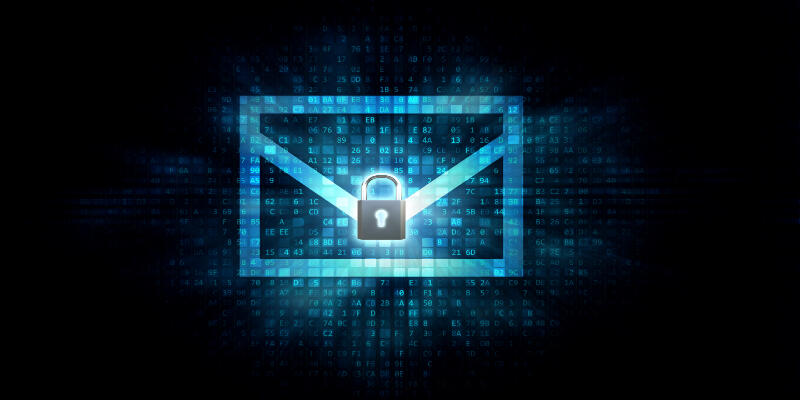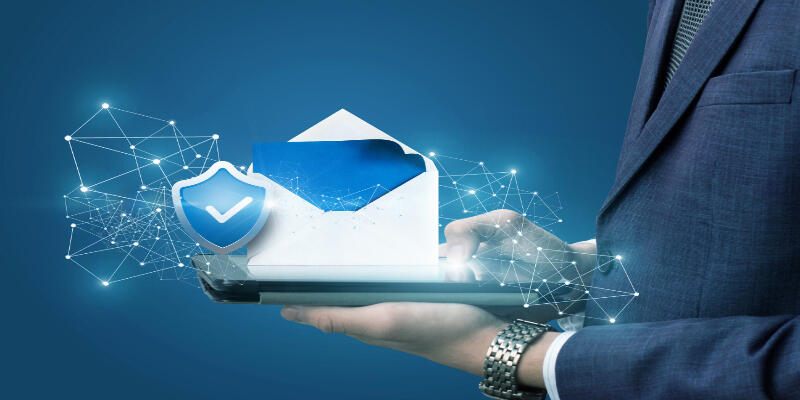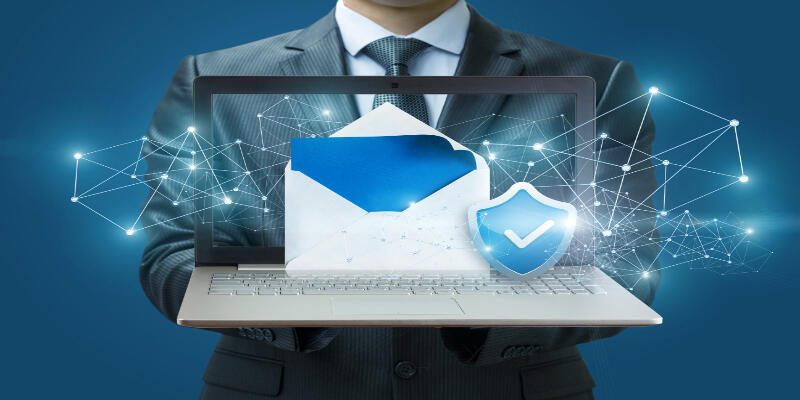Disclaimer: This post may contain affiliate links, meaning we get a small commission if you make a purchase through our links, at no cost to you. For more information, please visit our Disclaimer Page.
Security in emails is an unknown subject to most Gmail users. The thought of securing emails brings the feeling of mystery, applicable only by hackers and high intelligence government officials like we see it in movies. However, email encryption is critical and should be done every time you’re sending an email. But, is there a simple way to send a secure email in Gmail?
Gmail has best-in-class security features for securing emails and keeping your Gmail account safe. However, encrypting emails offers the ultimate protection to the information in the emails so that it is only accessible to the receiver.
Gmail services millions of users worldwide for both business and personal use. To protect these users and the emails they send, Google uses a standard encryption method called Transport Layer Security (TLS) so that no one can intersect or look at the message in the email while it’s en route to the receiver.
However, the message remains unprotected once it reaches its destination. This article discusses how you can further secure your email when sending it using Gmail.
Table of Contents
How Do I Send A Secure Email in Gmail?
Google has excellent security features to keep your email account safe and allow you to send secure emails. With these security features and privacy controls, Google seeks to protect their customer’s information as a staggering amount of data is sent through Gmail every second.
Whether you’re using Gmail for personal use or business communication, privacy in communication is a priority as sensitive information like customer information, bank account details, etc., are exchanged every day.
While Google offers protection on their end, there are a few steps you can take to beef up Gmail security when sending emails and keep your information safe. These steps include:
Check through Gmail’s security checklist.
Gmail provides a long list of measures you can take to improve your account’s security with only a few clicks. You can take advantage of some features like the visibility of IP addresses and locations where the account was last accessed. This will let you know when someone is trying to spy into your Gmail and from where.
The checklist prevents your system from compromising and helps you practice the best security practices like constantly updating your browser and using an anti-malware scanner. With this checklist, you can be sure your emails remain secure in whichever folder they are in.
Use non-obvious solid passwords.
Creating a password requires creativity to mix letters, numbers, and characters in both uppercase and lowercase and a unique pattern so that no one can easily guess it.
It’s not enough to write your pet’s name or your nickname as a password; anyone close to you can easily guess that.
Gmail accepts a password length of 200 characters so that you can write a complete sentence as your password. You’re unlikely to enter such as your password, but whatever the case, let it be something you can remember easily.
Enable 2-Step Verification
With a strong password, your account is protected. But you can put one more layer of security and strengthen your line of defense.
With this step, it will require anyone trying to log into your account to enter a one-time passcode sent to your phone. That means no one can access your email without your authorization.
Setting up 2-step verification will not directly secure your email. Still, it will prevent any unauthorized access to your account, and that’s an efficient way to protect the contents of your mailbox.
Recognize fraudulent emails and avoid them.
Such emails are sent for phishing attacks where hackers seek to access your account information through the emails. Most of them have links that require you to click. Once you click them, they get access to your account’s information and other sensitive information in your account.
You can identify them through simple red flags like misspelled words in the content, legal threats, unrealistic money promises, etc.
It’s best to avoid clicking on any links provided in such emails, and if you need clarifications on the content of the email, you can find the company’s website and log in here or contact the sender directly.
Use layer encryption for ultimate protection.
Passwords are great, multiple-step verifications are even better. But the ultimate protection for your email is through encryption.
This is because encryption conceals the information in your email and makes it difficult for an unauthorized person to access it.
There are several ways you can encrypt your email protected. Google offers a layer of encryption, but this works only when the email is within the Google servers.
The introduction of Google confidential has improved this security feature. These are not very effective as they do not have an end-to-end encryption service.
To improve it, most clients find other alternatives like client-side encryption methods such as S/MIME and PGP that use keys or certificates to access the messages, and third-party add-ons like Google Chrome’s Secure Gmail extension, which offer end-to-end encryption for all emails.
What is Email Encryption?
Email encryption is a way of hiding or disguising the contents of an email to ensure it is only received and read by the intended recipient. Sending emails over public or unsecured Wi-Fi networks increases vulnerability.
Such sensitive information like bank account details, account login credentials, social security numbers, etc., is at risk of being exposed to hackers.
Even though your email doesn’t contain sensitive information, any leak to hackers can give them access to your Gmail account and thus hijack it and access necessary attachments and information.
Encryption keeps your information private by making it unreadable so that even if someone successfully hijacks the email, they can’t read or make sense of the content in the email.
When encrypting your email, consider encrypting these three things.
The connection from your email provider, in this case, Gmail – As mentioned earlier, Gmail has a default encryption connection for all sent emails, which protects the emails sent to a receiver using Gmail or an email provider with TPS. This keeps the message safe while on transit.
The actual message written in the email – This means you encrypt the email before you send it and disguise the message. Even if it is intercepted while on transit, it’s useless to the hacker because the message is unreadable.
The email messages in the archive or the store – Most times, emails are stored in Gmail for future reference or whatever reason. Hackers can quickly gain access to your account and access these backed-up emails. Encrypting these emails keeps the contents of the emails safe and inaccessible.
The best practice when sending emails would always be to encrypt all your emails and those with sensitive information to raise red flags for hackers.
How Does An Encrypted Email Work?
Email encryption works through a Public Key Infrastructure (PKI) which combines a private key and a public key to encrypt the email.
The sender uses a public key to encrypt the email, but the recipient will require a unique private key to decrypt the message into readable format.
Here’s how it works.
- Both the sender and the receiver create a public key and a private key from their end and send each other the public keys.
- The sender uses the receiver’s public key to encrypt the message and sends it.
- The receiver uses their private key to decrypt the email and make the message readable.
An email sent in this manner remains private, and its contents are protected from prying eyes. You can send sensitive information like social security numbers and bank account details without worrying about their safety.
Security is a guarantee in end-to-end email encryption as it comes with a digital signature to authenticate you as the email sender. This layer of protection disqualifies the possibility of a hacker sending or tampering with the message.
With Gmail, there are other methods of encrypting an email, but they do not offer end-to-end encryption. This means that the message can be read or tampered with while on transit. For example, Google checks through all emails sent through their emailing service to help them spot phishing attacks and other malicious content. No wonder it’s able to suggest possible replies to emails you receive.
This spying through emails has raised privacy concerns in the past, so Google developed Gmail Confidential Mode as a cover-up, yet they still scam the messages, even those sent through this mode.
Further complaints led to creating third-party extensions like the Chrome and Firefox extensions that provide end-to-end encryption services.
Some services with Gmail that do not offer end-to-end encryption include:
SSL/TLS – You’ll notice this service as soon as you sign in to your Gmail account on the browser. The URL to the site starts with HTTPS, where S shows that the SSL/TLS protocols have been applied in encrypting the data exchanged between the Gmail servers and your computer.
Your data is safe from malicious intermediaries, but Google keeps the keys that decrypt the data. So they have access to all the information in the email.
STARTTLS – This allows email users to send emails across servers like yahoo and Gmail. When an email is sent over STARTTLS, the message between the servers remains encrypted.
However, this is not the best option for encrypting messages because both servers have access to the email and can read through the contents of the email. This creates a loophole for hackers to access the message too.
Can I Encrypt an Email in Gmail?
Google protects your messages through Gmail encryption. The Transport Layer Security encrypts the messages you send on Gmail and protects them from other eyes.
You can recognize it when you access your mailbox, as it shows on the URL box as a small lock icon.
It’s an effective way to encrypt messages but not sufficient to provide enough security. For example, if you’re sending an email and anti-virus with message-checking services, it offers a loophole for an attack.
The message is safe while on transit but can be easily accessed from the receiver’s inbox, as the message itself is not encrypted.
TLS protects only the channel of communication while the contents of the email remain unprotected. This makes it vulnerable to hackers and unwelcome Google’s surveillance as they scam your emails for spam content and suspicious phishing attacks.
Considering TLS’s inefficiencies and breach of privacy, Google introduced different services to help Gmail users send their messages confidently. You can use any of these three ways to encrypt your email in Gmail.
Gmail Confidential mode
As the name suggests, Google now allows users to send confidential emails by enabling the confidential mode from their compose window.
Once you activate the confidential mode, you’ll be expected to follow some extra steps and choose some options to secure your email. These options include:
- You can set an expiry date so that the email is only available for a specified timeframe. After the time expires, the email is no longer readable.
- You’ll be required to provide your phone number and your recipient’s number, where you can receive an SMS with the passcode to open the email.
- You can disable some email functions like copy and paste, forward, print, and download the contents of the email.
On the downside, this method of encryption does not offer end-to-end encryption, so the email contents can still be accessed. Although Google launched this feature to increase the security levels of the email, it doesn’t scale up well as Google can still spy through the contents of the email.
It also requires far too many extra steps for the sender and the receiver before sending or viewing the email.
This method may not be so confidential as Google requires you to provide your phone number for the passcode, and maybe you want to keep your phone number private.
On the expiring date, it’s expected to make the message disappear after the set period. Still, both the sender and the receiver can retrieve the email from Google after it has disappeared.
Use S/MIME for Google
S/MIME stands for Secure/Multipurpose Internet Mail Extensions. It’s an excellent encrypting tool that supports encryption for outgoing emails and those in transit.
Both the recipient and the sender are supposed to enable the S/MIME encryption before the email is sent.
When you enable the S/MIME, you receive keys that identify the sender and the receiver. Both have to share these keys to know each other. After sharing the keys, you follow this process to send the email.
Step 1 – Go to the compose message box and type in your message like in any other email.
Step 2 – On the ‘To’ space, add the recipient’s email address.
Step 3 – Since the S/MIME is enabled, a lock icon will appear at the right end of the recipients’ address. The type of icon will depend on the recipient’s encryption level. If the message is going to many people, you’ll see an icon that shows a low encryption level depending on the individual encryption levels for all the recipients.
Step 4 – Click on the lock icon to view the details and encrypt the email. You can then send the email.
If you’re the recipient, you can check the level of encryption applied to the email you received. A green lock on the message means that the message was S/MIME encrypted, and you’ll need a private key to decrypt and read the email.
If the lock is gray, only TLS encryption was applied, and if the lock is red, then no encryption whatsoever was used. Before you start sending sensitive information via email, you can first try sending a few emails and be sure you can correctly encrypt your emails.
Use Secure Gmail
This is a chrome extension that introduces a lock icon on the compose button in your Gmail. You can download it from the Chrome Web Store and install it on Chrome. Refresh Gmail, and you’ll notice the lock icon.
This encryption method provides end-to-end encryption, so the email and its contents are only accessible to the intended receiver.
To send an encrypted message using this feature, you’ll need to click on the lock icon (if you click on the compose icon, you’ll send an unencrypted message).
On clicking on the lock, the message window that appears has a red ‘New Message’ tab with ‘secured’ written next to it. The ‘Send’ icon also changes to ‘Send Encrypted’ for the email.
If these features are not showing on your compose window, then your message will not be encrypted. But if these features are showing, enter your message and send it. You’ll be prompted to enter a password that will be required when decrypting the message.
You can hint the password to the receiver, or you can send it manually to them so that they can use it to view the message. If the receiver has the Secure Gmail extension, the email sent will have end-to-end encryption, meaning that even Google will have no access to the email contents.
This extension is only limited to Chrome; therefore, you must open the email using Chrome. Otherwise, you’ll not have access to the email.
For those who prefer using Firefox to access Gmail, there’s a way you can encrypt your emails using an Encrypted Communication extension of Firefox. You’ll need to install the extension on your Firefox, close the application, and restart it to activate the extension.
To encrypt your email on the Firefox browser, you’ll follow this simple process.
- Open Gmail on your Firefox browser and compose your email normally.
- Right-click on the space and choose ‘Encrypt Communication’ from the menu that pops up.
- Enter the password and click on ‘OK’ to send the message.
The recipient will need to have a similar extension on their Firefox so that they can access the message. The recipient will right-click on the email and choose ‘Decrypt communication,’ then enter the password to open the message.
The choice of the best encryption method to use for your communication is dependent on the level of security you need for your emails. Even though you’re not sending sensitive information, it is always good to encrypt your emails and always be safe.
Conclusion
As technology advances, hackers and malicious cybercriminals seek to access information from unsuspecting people and use it against them to facilitate their crimes. To keep your information safe from such people, it’s crucial to take steps that will protect you and your data.
Always check to ensure that your account passwords are safe, you have 2-step Verification in place, and that your emails are encrypted every time.



